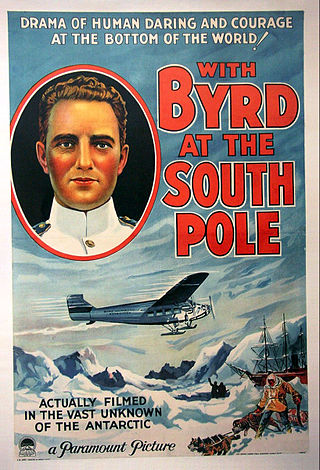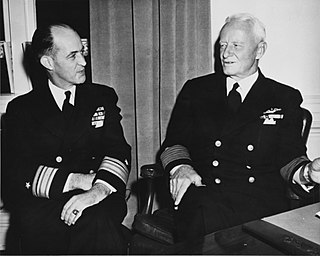
Richard Evelyn Byrd Jr., an American naval officer, was a pioneering American aviator, polar explorer, and organizer of polar logistics. Aircraft flights in which he served as a navigator and expedition leader crossed the Atlantic Ocean, a segment of the Arctic Ocean, and a segment of the Antarctic Plateau. He is also known for discovering Mount Sidley, the largest dormant volcano in Antarctica.

James Vincent Forrestal was the last Cabinet-level United States Secretary of the Navy and the first United States Secretary of Defense.

Paul Allman Siple was a North American Antarctic explorer and geographer who took part in six Antarctic expeditions, including the two Byrd expeditions of 1928–1930 and 1933–1935, representing the Boy Scouts of America as an Eagle Scout. In addition to being an Eagle Scout, Siple was also a Sea Scout. His first and third books covered these adventures. With Charles F. Passel he developed the wind chill factor, and Siple coined the term.

Operation HIGHJUMP, officially titled The United States Navy Antarctic Developments Program, 1946–1947,, was a United States Navy (USN) operation to establish the Antarctic research base Little America IV. The operation was organized by Rear Admiral Richard E. Byrd, Jr., USN, Officer in Charge, Task Force 68, and led by Rear Admiral Ethan Erik Larson, USN, Commanding Officer, Task Force 68. Operation HIGHJUMP commenced 26 August 1946 and ended in late February 1947. Task Force 68 included 4,700 men, 70 ships, and 33 aircraft.

Little America was a series of Antarctic exploration bases from 1929 to 1958, located on the Ross Ice Shelf, south of the Bay of Whales.
Operation Deep Freeze is codename for a series of United States missions to Antarctica, beginning with "Operation Deep Freeze I" in 1955–56, followed by "Operation Deep Freeze II", "Operation Deep Freeze III", and so on.. Given the continuing and constant US presence in Antarctica since that date, "Operation Deep Freeze" has come to be used as a general term for US operations in that continent, and in particular for the regular missions to resupply US Antarctic bases, coordinated by the United States military. Task Force 199 was involved.

Charles Butler McVay III was an American naval officer and the commanding officer of the cruiser USS Indianapolis which was lost in action in 1945, resulting in a significant loss of life. Of all captains in the history of the United States Navy, he is the only one subjected to court-martial for losing a ship sunk by an act of war, despite the fact that he was on a top secret mission maintaining radio silence.
Bunger Hills, also known as Bunger Lakes or Bunger Oasis, is a coastal range on the Knox Coast in Wilkes Land in Antarctica, consisting of a group of moderately low, rounded coastal hills, overlain by morainic drift and notably ice free throughout the year, lying south of the Highjump Archipelago. The reasoning behind the minute amount of ice in the area is still relatively unknown and remains under intense debate amongst scientists today.
The United States Antarctic Service Expedition (1939–1941), often referred to as Byrd’s Third Antarctic Expedition, was an expedition jointly sponsored by the United States Navy, State Department, Department of the Interior and The Treasury. Although a U.S.-government sponsored expedition, additional support came from donations and gifts by private citizens, corporations and institutions.
Mount McClintock is the highest mountain in the Britannia Range in Antarctica, surmounting the south end of Forbes Ridge, 6 nautical miles east of Mount Olympus.

George John Dufek was an American naval officer, naval aviator, and polar expert. He served in World War II and the Korean War and in the 1940s and 1950s spent much of his career in the Antarctic, first with Admiral Byrd and later as supervisor of U.S. programs in the South Polar regions. Rear Admiral Dufek was the director of the Mariners' Museum in Newport News, Virginia after his retirement from the Navy in 1959.

The Gallant Hours is a 1960 American docudrama about William F. Halsey, Jr. and his efforts in fighting against Admiral Isoroku Yamamoto and the Imperial Japanese Navy in the Guadalcanal campaign of World War II.
Hughes Basin is a large basinlike névé which is bounded except to the south by the Ravens Mountains, Mount Henderson, Mount Olympus and Mount Quackenbush. The feature is 15 nautical miles long and the ice surface descends north–south from 2,000 metres (6,600 ft) near Mount Olympus to 1,000 metres (3,300 ft) near Darnell Nunatak, where there is discharge to Byrd Glacier.

With Byrd at the South Pole (1930) is a sound part-talkie documentary film about Rear Admiral Richard E. Byrd and his 1st quest to the South Pole beginning at the Little America-Exploration Base. In addition to sequences with audible dialogue or talking sequences, the film features a synchronized musical score and sound effects along with English intertitles. The dialogue sequences consist mainly of narration that is read aloud by Floyd Gibbons. The film won at the 3rd Academy Awards for Best Cinematography.

Air Development Squadron Six was a United States Navy Air Development Squadron based at McMurdo Station, Antarctica. Established at Naval Air Station Patuxent River, Maryland on 17 January 1955, the squadron's mission was to conduct operations in support of Operation Deep Freeze, the operational component of the United States Antarctic Program.
Hollywood in Uniform is a 1943 American short documentary film directed by Ralph Staub as part of the Screen Snapshots series. It was nominated for an Academy Award at the 16th Academy Awards for Best Short Subject (One-Reel).

Richard Harold Cruzen was a decorated United States Navy officer with the rank of Vice Admiral. A veteran of both World Wars, he is best known for his participation and leadership in Antarctic expeditions.

The City of New York was a steam barquentine best known for being Richard E. Byrd's flagship on his 1928–30 exploration of Antarctica, mistakenly for the rescue of Shackleton in 1915, and most infamously for possibly being the ship that failed to come to the aid of the Titanic in 1912. Her name was changed several times; originally named Samson (1885–1914), she was renamed the Jacobsen (1915–1919), and then the Belsund (1919–1926), and back to Samson (1926–1928), before being finally dubbed the City of New York in 1928.

International competition extended to the continent of Antarctica during the World War II era, though the region saw no combat. During the prelude to war, Nazi Germany organised the 1938 Third German Antarctic Expedition to preempt Norway's claim to Queen Maud Land. The expedition served as the basis for a new German claim, called New Swabia. A year later, the United States Antarctic Service Expedition established two bases, which operated for two years before being abandoned. Responding to these encroachments, and taking advantage of Europe's wartime turmoil, the nearby nations of Chile and Argentina made their own claims. In 1940 Chile proclaimed the Chilean Antarctic Territory in areas already claimed by Britain, while Argentina proclaimed Argentine Antarctica in 1943 in an overlapping area.













